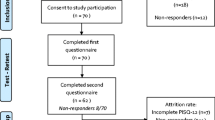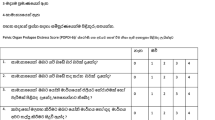Abstract
The aim of this study was to design and validate an interviewer-administered pelvic floor questionnaire that integrates bladder, bowel and sexual function, pelvic organ prolapse, severity, bothersomeness and condition-specific quality of life. Validation testing of the questionnaire was performed using data from 106 urogynaecological patients and a separately sampled community cohort of 49 women. Missing data did not exceed 2% for any question. It distinguished community and urogynaecological populations regarding pelvic floor dysfunction. The bladder domain correlated with the short version of the Urogenital Distress Inventory, bowel function with an established bowel questionnaire and prolapse symptoms with the International Continence Society prolapse quantification. Sexual function assessment reflected scores on the McCoy Female Sexuality Questionnaire. Cronbach’s α coefficients were acceptable in all domains. Kappa coefficients of agreement for the test–retest analyses varied from 0.5 to 1.0. The interviewer-administered pelvic floor questionnaire assessed pelvic floor function in a reproducible and valid fashion in a typical urogynaecological clinic.


Similar content being viewed by others
References
Shumaker SA, Wyman JF, Uebersax JS, McClish D, Fantl JA (1994) Health-related quality of life measures for women with urinary incontinence: the Incontinence Impact Questionnaire and the Urogenital Distress Inventory. Continence Program in Women (CPW) Research Group. Qual Life Res 3:291–306
Uebersax JS, Wyman JF, Shumaker SA, McClish DK, Fantl JA (1995) Short forms to assess life quality and symptom distress for urinary incontinence in women: the Incontinence Impact Questionnaire and the Urogenital Distress Inventory. Continence Program for Women Research Group. Neurourol Urodyn 14:131–139
Kelleher CJ, Cardozo LD, Khullar V, Salvatore S (1997) A new questionnaire to assess the quality of life of urinary incontinent women. Br J Obstet Gynaecol 104:1374–1379
Barber MD, Kuchibhatla MN, Pieper CF, Bump RC (2001) Psychometric evaluation of 2 comprehensive condition-specific quality of life instruments for women with pelvic floor disorders. Am J Obstet Gynecol 185:1388–1395
Jackson S, Donovan J, Brookes S, Eckford S, Swithinbank L, Abrams P (1996) The Bristol Female Lower Urinary Tract Symptoms questionnaire: development and psychometric testing. Br J Urol 77:805–812
Baessler K, O’Neill SM, Maher CF, Battistutta D (2008) An interviewer-administered validated female pelvic floor questionnaire for community-based research. Menopause 15(5):973–977
Travers C, O’Neill SM, King R, Battistutta D, Khoo SK (2005) Greene Climacteric Scale: norms in an Australian population in relation to age and menopausal status. Climacteric 8:56–62
Baessler K, O’Neill S, Maher CF, Battistutta D (2004) A validated pelvic floor questionnaire: for clinicians and researchers. Neurourol Urodynam 23:398–399
Heaton KW, Ghosh S, Braddon FEM (1991) How bad are the symptoms and bowel dysfunction of patients with the irritable bowel syndrome? A prospective, controlled study with emphasis on stool form. GUT 32:73–79
McCoy NL (2000) The McCoy female sexuality questionaire. Qual Life Res 9:739–745
Bump RC, Mattiasson A, Bo K, Brubaker LP, DeLancey JOL, Klarskov P et al (1996) The standardization of terminology of female pelvic organ prolapse and pelvic floor dysfunction. Am J Obstet Gynecol 175:10–17
Heaton KW, Ghosh S, Braddon FE (1991) How bad are the symptoms and bowel dysfunction of patients with the irritable bowel syndrome? A prospective, controlled study with emphasis on stool form. Gut 32:73–79
Gill TM, Feinstein AR (1994) A critical appraisal of the quality of quality-of-life measurements. JAMA 272:619–626
Koch GG, Landis JR, Freeman JL, Freeman DH Jr., Lehnen RC (1977) A general methodology for the analysis of experiments with repeated measurement of categorical data. Biometrics 33:133–158
Bland JM, Altman DG (1986) Statistical methods for assessing agreement between two methods of clinical measurement. Lancet 1:307–310
Avery KN, Bosch JL, Gotoh M, Naughton M, Jackson S, Radley SC et al (2007) Questionnaires to assess urinary and anal incontinence: review and recommendations. J Urol 177:39–49
Amarenco G, Arnould B, Carita P, Haab F, Labat JJ, Richard F (2003) European psychometric validation of the CONTILIFE: a Quality of Life questionnaire for urinary incontinence. Eur Urol 43:391–404
Kulseng-Hanssen S, Borstad E (2003) The development of a questionnaire to measure the severity of symptoms and the quality of life before and after surgery for stress incontinence. Bjog 110:983–988
Bug GJ, Kiff ES, Hosker G (2001) A new condition-specific health-related quality of life questionnaire for the assessment of women with anal incontinence. BJOG 108:1057–1067
Reilly WT, Talley NJ, Pemberton JH, Zinsmeister AR (2000) Validation of a questionnaire to assess fecal incontinence and associated risk factors: Fecal Incontinence Questionnaire. Dis Colon Rectum 43:146–153; (discussion 153–4)
Lukacz ES, Lawrence JM, Buckwalter JG, Burchette RJ, Nager CW, Luber KM (2005) Epidemiology of prolapse and incontinence questionnaire: validation of a new epidemiologic survey. Int Urogynecol J Pelvic Floor Dysfunct 16:272–284
Shaw C, Matthews RJ, Perry SI, Williams K, Spiers N, Assassa RP et al (2004) Validity and reliability of a questionnaire to measure the impact of lower urinary tract symptoms on quality of life: the Leicester Impact Scale. Neurourol Urodyn 23:229–236
Geller EJ, Barbee ER, Wu JM, Loomis MJ, Visco AG (2007) Validation of telephone administration of 2 condition-specific quality-of-life questionnaires. Am J Obstet Gynecol 197:632 e1–e4
Kwon S, Visco AG, Fitzgerald MP, Ye W, Whitehead WE (2005) Validity and reliability of the Modified Manchester Health Questionnaire in assessing patients with fecal incontinence. Dis Colon Rectum 48:323–331; discussion 331–334
Author information
Authors and Affiliations
Corresponding author
Additional information
The validation of the interviewer-administered pelvic floor questionnaire was presented at the Annual Meeting of the International Continence Society in 2004, Paris (podium presentation; extended abstract): A validated female pelvic floor questionnaire for clinicians and researchers, Baessler K, O’Neill S, Maher C, Battistutta D, Neurourol Urodynam 2004; 23: 398–399.
Appendix—Australian Interviewer-Administered Pelvic Floor Questionnaire for patients with pelvic floor disorders.
Appendix—Australian Interviewer-Administered Pelvic Floor Questionnaire for patients with pelvic floor disorders.
PATIENT: DATE: \
PRIMARY PROBLEM: Duration:
SECONDARY:
Bladder section Q 1–15 Score ____/ 45 = ______
Bowel Section Q16–27 Score _____/ 34 = ____
Prolapse section Q28 –32 Score _____/15 = ______

Rights and permissions
About this article
Cite this article
Baessler, K., O’Neill, S.M., Maher, C.F. et al. Australian pelvic floor questionnaire: a validated interviewer-administered pelvic floor questionnaire for routine clinic and research. Int Urogynecol J 20, 149–158 (2009). https://doi.org/10.1007/s00192-008-0742-4
Received:
Accepted:
Published:
Issue Date:
DOI: https://doi.org/10.1007/s00192-008-0742-4




